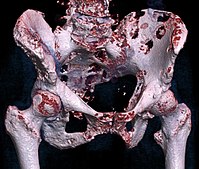
Photo from wikipedia
Osteoplasty is a minimally invasive imaging-guided intervention providing mechanical stabilization, bone consolidation and pain relief in oncologic patients presenting with non-osteoblastic bone metastases or with insufficiency fractures. The intervention relies… Click to show full abstract
Osteoplasty is a minimally invasive imaging-guided intervention providing mechanical stabilization, bone consolidation and pain relief in oncologic patients presenting with non-osteoblastic bone metastases or with insufficiency fractures. The intervention relies on the injection of an acrylic substance (ie, polymethylmethacrylate; PMMA) into the target bone. PMMA is very resistant to axial compressive loads but much less to bending, torsional and shearing stresses. Accordingly, from a biomechanical standpoint osteoplasty is adapted for the palliative treatment of small painful lytic bone defects located in the epiphyseal region of long bones in patients with clear surgical contraindications; or for increasing the anchoring of the osteosynthesis material into the target bone. Although pain relief is rapid and effective following osteoplasty, secondary fractures have been reported in up to 8-9% of long bone tumors undergoing such intervention; and following such event, fixation with endomedullary osteosynthetic material (eg, nailing) is not practicable any more. Accordingly, careful patients' selection is critical and should happen with a multidisciplinary approach.
Journal Title: Techniques in vascular and interventional radiology
Year Published: 2022
Link to full text (if available)
Share on Social Media: Sign Up to like & get
recommendations!